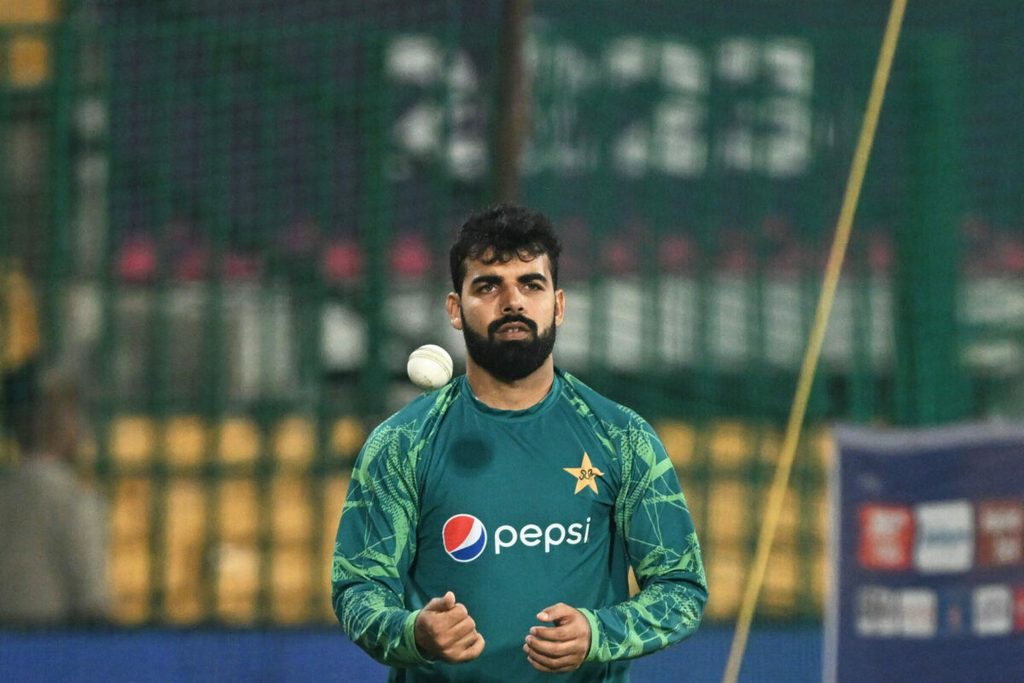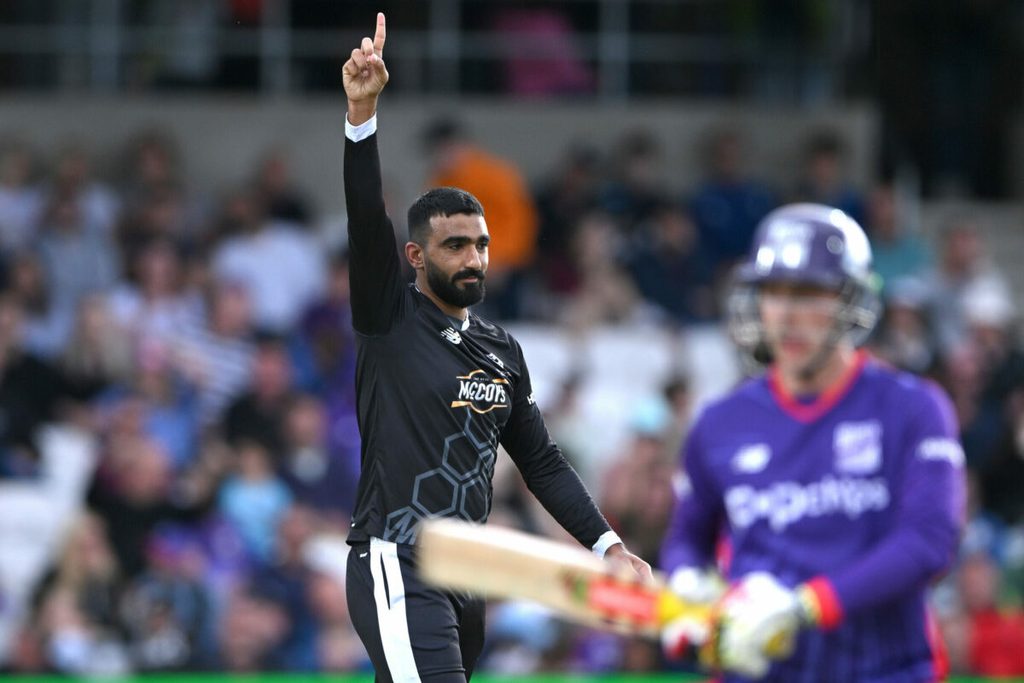
After their loss to India, Pakistan dropped their vice-captain for the exciting Usama Mir. Aadya Sharma, at the Australia-Pakistan game, writes on his underwhelming World Cup debut, and why it shouldn’t be taken at face value.
To bet on the World Cup with our Match Centre Partners bet365 head here.
For the first ten overs, Usama Mir‘s World Cup debut was all about one dropped catch. The ball slipped right through him, thudding into the chest and plopping to the ground. Over the next few moments, Usama looked twice at his palms, and once at the sky. He must have been itching to hold that ball again.
Twenty-two overs later, when another missed chance at deep midwicket gave Abdullah Shafique an injured finger and the teams a drinks break, Usama, now as a bowler, had disappointment writ large on his face. He was two balls into his second spell, when another drop had come. The first four overs had accounted for 31 runs.
As Usama stood, it was Shadab Khan, Shafique’s substitute, who came up to the bowler and had a quick chat. Not too long ago, Shadab had been replaced by Usama in the XI, putting a pause on Shadab’s recent patch of lacklustre showings.
In a bowling attack already beleaguered by absences and patchy form, Usama’s entry, on paper, seemed to be a handy addition. Pakistan’s spin problems aren’t new: since the start of 2022, among all teams to play men’s ODIs, the bowling average of Pakistan spinners – 43.36 – ranks 18th out of 22 and the economy – 5.54 – is 19th out of 22. They walked into this World Cup without a standout, premier spinner in their ranks.
Shadab, as vice-captain, bowling all-rounder and gun fielder, seemed to be an automatic choice for the World Cup. There was space to accommodate just one leg-spinner, and Shadab fit that bill. At least it seemed so.
But Shadab had his own set of issues. Since the start of 2022, he averages 37.65 with the ball, and 27.83 with the bat. At the Asia Cup, he had gone below an economy of six in just two out of five games, against Nepal and Bangladesh. In his first three games at the World Cup, the numbers stood at 5.62 v Netherlands, 6.87 v Sri Lanka and 7.75 v India.
[caption id=”attachment_588201″ align=”alignnone” width=”1200″] Shadab Khan has struggled at the World Cup[/caption]
Shadab Khan has struggled at the World Cup[/caption]
Shadab’s competitor for that spot is Usama, and the face-off has a long history. In PSL 2017, the breakout season for both, Usama was Karachi Kings’ leading wicket-taker – 12 wickets at 19. Shadab, for Islamabad United, plucked nine wickets at 19.11. The difference was their economy rates: Shadab had gone at 6.61, while Usama went at 8.19. Days later, Shadab had made his international debut at 19. Now, he’s their ODI vice-captain.
Usama, two years older than Shadab, has had a different journey. At the 2017 ACC Emerging Teams Asia Cup, he was the leading wicket-taker (13 wickets at 10.23), and Punjab’s top wicket-taker in the 2018 Pakistan Cup. It was also when he gave an account of his lower-order big-hitting, finishing with a strike rate of 162.50.
Six years later, the paths are intersecting again. In August, a tweet revealed one of Usama’s goals for 2023 was to play The Hundred, which he did for the Manchester Originals, picking six wickets at 23.16. It included a memorable all-round show against Birmingham Phoenix: two vital wickets – one of Shadab – in figures of 2-27. Earlier, he had blitzed an unbeaten, 14-ball 32. The promise was unmissable.
Months prior to that, he had dazzled on his Blast debut, first smashing 20* off 7, and then plucking 3-21, which bagged him a County Championship gig too. By then, he had already played ODI cricket, and taken a four-for, against New Zealand, in just his fifth game.
Shadab’s continued struggle prompted another look-in for Usama. At the World Cup, on Indian pitches, it looked like the right move.
The World Cup debut wasn’t one to remember, for the most part. In his first spell, he was either too short, giving David Warner and Mitchell Marsh enough time to rock back and clatter the ball away, or too full, letting them drill it through covers with ease. The delivery that brought up Warner’s half-century said it all: a ball before that, he had turned one into Warner, one of the rare deliveries that seemed to have troubled him today. Immediately, he erred by bowling a full toss, and was punished with a boundary through mid-wicket.
Later on, the lengths got better, resulting in more dots and more control, but he leaked runs again after the Shafique drop. Warner, very nearly having handed a difficult chance in the deep, was greeted with another long-hop the next ball, and nonchalantly clanked it over the exact same region in a show of power.
After the forced drinks break, Usama overcompensated with two over-pitched lollypops, and Warner gladly smacked both through the covers, exposing rawness that will only be fixed with experience. Mohammad Rizwan just stared back in disbelief.
There was a little ray of hope when Steve Smith was seemingly undone in the 35th over, an outside edge flying to first slip. But there was another dropped catch, the third that Usama was involved in. Babar was on the ground, the disappointment evident.
He tried to search for the right lengths thereafter, and benefitted from a change of gears, extracting revenge on Smith. A loopy, full one was slapped back to Usama, who pouched it with ease. There was no celebration.
The spell, which ended with a six, eventually read 9-0-82-1.
[caption id=”attachment_588202″ align=”alignnone” width=”1200″] Usama Mir impressed in The Hundred with his all-round display for Manchester Originals[/caption]
Usama Mir impressed in The Hundred with his all-round display for Manchester Originals[/caption]
The Bengaluru ground can’t have been an easy launch pad. Yuzvendra Chahal, probably the most successful leg-spinner at this venue, recently joked in an interview with Wisden India that he had only seen sixes hit at the ground, not fours. Since the start of 2010, among all of the 29 venues where men’s ODIs have been played in India, the Chinnaswamy Stadium has the fourth-highest economy rate for spinners – 5.78.
After the game, David Warner, who inflicted the most pounding on Usama had words of support for the leggie.
“Unfortunately for Usama, he also had a left-hander in there for most of the innings,” Warner said. “Not easy as a leg-spinner to keep trying to bowl to a left-hander. And I felt like he held his length pretty well. And when you’re none for 150 or 200, it’s very challenging as a bowler. So, I wouldn’t discredit the way that he bowled.”
The Australia match was a predictable run-fest on a flat pitch with small dimensions. Usama’s initial impression might not have been the best, but there were the odd deliveries that carried promise. With a bit more tuning, he can be what Pakistan expects of him: a tall leg-spinner capable of turn and some extra bounce, and a handy googly to boot. Although not as polished as Shadab, he can bat a bit too. What he does need is some backing and a venue not as averse as Bengaluru.
“Everybody in the dressing room will put their arms around Usama and support him,” bowling coach Morne Morkel assured.
It proved to be a target to big to assail, and Pakistan will be hurting from back-to-back losses now, their campaign all too familiarly in sticky territory. The spin attack has largely let down so far, but in Usama, there’s hope for a brighter future.








